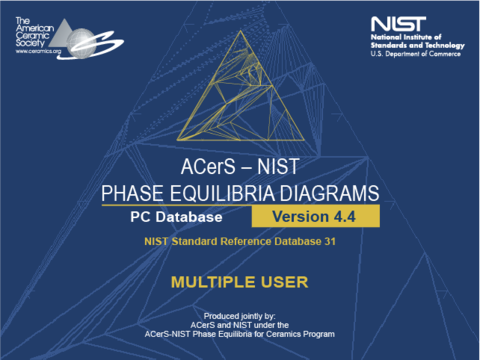
Version 4.4 of (Phase Equilibria Diagrams (Standard Reference Database 31) is now available to the public. The data provide maps of the equilibrium chemical and structural behaviors exhibited by inorganic systems and provide critical starting information for the rational design of materials processing schemes, for quality assurance efforts, and for optimization of the physical and chemical properties of advanced materials. The database began as a series of hard-copy books entitled Phase Diagrams for Ceramists which were published from 1964 to 1992 as the result of a joint commitment with The American Ceramic Society to develop and maintain a state-of-the-art database of critically evaluated phase equilibria data for industrial and academic customers. In 1992 the title was changed to the more general Phase Equilibria Diagrams to emphasize that the data are useful to the broader materials community.
The Phase Equilibria Diagrams Database contains commentaries and more than 29,000 diagrams for non-organic systems, including those published in all 21 hard-copy issues: Volumes I through XIV ("blue books"); Annuals 91, 92, 93; High Tc Superconductors I & II; special‐Volume P (phosphorus‐containing); Zirconium & Zirconia Systems; and Electronic Ceramics I. Materials covered include oxides as well as non-oxide systems such as chalcogenides and pnictides, phosphates, salt systems, and mixed systems of these classes.
Version 4.4 provides 374 new entries with 772 new diagrams. The new content includes experimental and calculated data for a wide range of non‐organic material‐types including oxides and mixed systems with oxides, chalcogenides (sulfides, selenides, tellurides), pnictides (N, P, As, Sb, Bi), actinides (U, Pu, Th) and actinide‐surrogates (Ce), oxy‐cation systems (e.g. molybdates, vanadates), semiconductors (Si, Ge, Sn), group 3 systems (B, Al, Ga, In, Tl), and salts including mixed systems with salts. The data are pertinent to a wide variety of applications and include systems of interest for renewable energy technologies (e.g. heat-storage/transfer materials, conversion phosphors, photovoltaics, molten electrolytes, advanced anode and electrolyte materials for battery applications, nuclear-reactor technology and radioactive waste recycling) and next-generation electronic, magnetic, photonic, and optoelectronic devices (e.g. proton conductors, luminescent hosts, solid-electrolyte membranes, liquid-crystal displays, electrochemical sensors, magnetic sensors, actuators, capacitors, transducers, thermoelectric elements, memory elements, fluorescent LED materials, laser hosts, optical fibers, magnetic refrigerators, thermoluminescent elements). The collection includes data for material systems of interest in other diverse applications such as antibacterial agents, bio-compatible ceramics, cutting materials, fluxes for metallurgical processing/electrolytic refining, improved cement, ceramic filters, semiconductor manufacturing, catalysts and photo-catalysts, thermal‐barrier coatings, pigments, and fuel cells.
SRD31 Version 4.4 is available for purchase as a PC product (at http://www.nist.gov/srd/nist31.cfm) and also online as a subscription (see http://ceramics.org/buyphase). NIST staff and Associates with computers having NIST IP addresses (Gaithersburg and Boulder) can access SRD31 online free of charge at https://phaseonline.ceramics.org.

